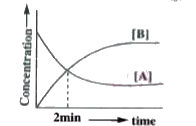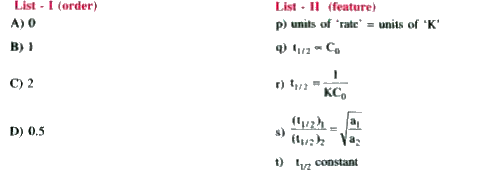For a first order reaction A(g)⇔3B(g) the concentration verses time graph is given below:

What is the half life in minutes (answer to nearest intetger)?Solution in Telugu
The correct Answer is:5
A⇔3B
A0 0
(A0−x) 3x
(3A04) 3A04
Here A0/4,K×t=2.303log(C0C1),K×2=2.303×lot(A03A0/4)
K=2.3032×log(43)=2.3032×(log4−log3)=2.3032×0.1249
(t12)=0.693K=0.693(2.303×0.12492),t12=(0.3010×20.1249)=4.8198.t12≅5
Topper's Solved these Questions
- BOOK - AAKASH SERIESCHAPTER - CHEMICAL KINETICSEXERCISE - PRACTICE SHEET-1 (SINGLE OR MORE THAN ONE OPTION QUESTIONS)16videos
CHEMICAL KINETICS
- BOOK - AAKASH SERIESCHAPTER - CHEMICAL KINETICSEXERCISE - PRACTICE SHEET-1 (LINKED COMPREHENSION TYPE QUESTIONS)6videos
CHEMICAL KINETICS
- BOOK - AAKASH SERIESCHAPTER - CHEMICAL KINETICSEXERCISE - LEVEL-II(LECTURE SHEET EXERCISE-III MATCH THE FOLLOWING QUESTIONS)3videos
CHEMICAL KINETICS
- BOOK - AAKASH SERIESCHAPTER - CHEMICAL KINETCSEXERCISE - EXERCISE - 3.245videos
CHEMICAL KINETCS
- BOOK - AAKASH SERIESCHAPTER - CHEMICAL THERMODYNAMICSEXERCISE - Additional Practice Exercise54videos
CHEMICAL THERMODYNAMICS
Similar Questions
For the reaction N2+3H2→2NH3 , the rate d[NH3]dt=2×10−4Ms−1. Therfore the rate −d[N2]dt is given
01:01View SolutionThe instantaneous rate of an elementary chamical reactkon aA+bB⇔cC+dD can be given by rate =Kf[A]a[B]b−Kb[C]c[D]d where Kf and Kb are rate constants for forward and backward reactions respectively for the reversible reaction. If the reaction is an irreversible one, the rate is expressed as, rate =K[A]a[B]b where K is rate contant for the given irreversible rate of disappearance of A is a/b times the rate of disappearance of B. The variation of rate constant K with temperature is expressed in terms of Arrhenius equation: K=Ae−Ea/RT whereas the ratio KfKb is expressed in terms of van't Hoff isochore: KfKb=Ae−ΔH/RT, where Ea and ΔH are energy of activation and heat of reaction respectively.
The variation of rate constant K and KfKb with temperature shows the following effects:
For endothrmic reaction when T increases then K increases and KfKb also increases.
(ii) For endothemic reaction when T decreases then K decreases and KfKb also decreases.
(iii) For exothermic when T increases then K and KfKb both increases.
(iv) For exothermic reaction when T decreases then K increases and KfKb decrease.
(v) For exothermic reaction when T increases thenK and KfKb both decrease.02:35View SolutionMatch the following columns
 05:49View Solution
05:49View SolutionDiscuss on the kinetic spontaneity of a chemical reaction. Is a slow reaction spontaneous? Why?
03:49View SolutionWhich among the following is not an exact differential?
View SolutionFor the first order reaction half-life time is ………….. on the initial concentration.
View SolutionIn a first order reaction , the concentration of the reactant is reduced to 1/8 of the initial concentration in 75 minutes at 298 K . What is the half-life period of the reaction in minutes
03:21View Solutionएक प्रथम कोटि की अभिक्रिया का अर्ध-आयु काल 10 मिनट है यदि अभिक्रिया प्रारंभिक सान्द्रता12M के साथ सुरु की जाती है तो 20 मिनट दर होगी
03:24View SolutionThe half life of a first order reaction is 10 years . The time taken by 10 g of the reactant to reduce its half is ______.
02:16View SolutionA(g) to B(g) + C(g) Initial concentration of A is 20 M and concentration of C after 18 minutes is 15 M then calculate half life time (in minues) of reaction (Assuming decomposition of A follows first order Kinetics).
03:42View SolutionAt particular concentration, the half life of the reaction is 100 minutes. When the concentration of reactant becomes double half life becomes 25 minutes, then what will be the order of the reaction ?
04:59View SolutionHalf life time for first order reaction is 25 minutes . What time will be required for 99% completion of reaction ?
04:04View SolutionAt particular concentration , the half life of the reaction is 100 minutes. When the concentration of the reactant become double half life becomes , 25 minutes , then what will be the order of the reaction ?
03:58View SolutionFor a first order reaction, if ‘a’ is the initial concentration of reactant, then the half life time is
02:17View Solutionअभिक्रिया X(g)→Y(g)+Z(g) के लिये अर्द्ध-आयुकाल 10 मिनट है कितने समय में X की सान्द्रता इसकी मूल सान्द्रता से 10% रह जायेगी
06:44View Solution

